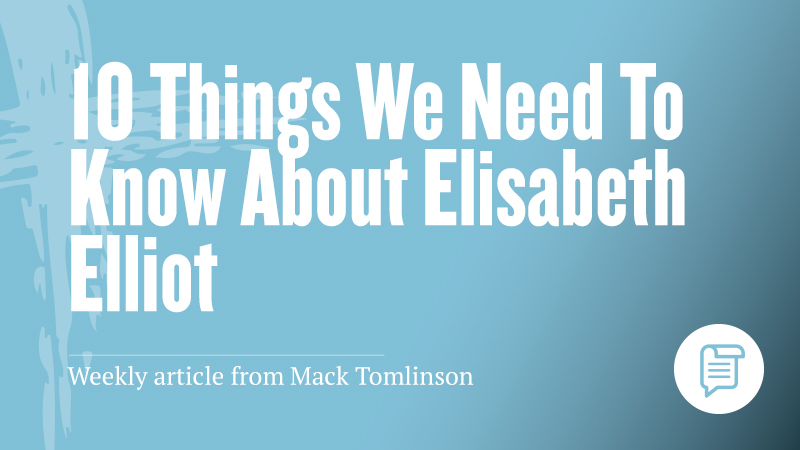
1. There’s much more to Elisabeth Elliot than Ecuador in 1956.
With the world poised on the cusp of the space race, Americans were fascinated by the story of five clean-cut young missionary men killed in the Amazon jungle by unknown warriors using spears. Through Gates of Splendor, Elisabeth Elliot’s first-hand account of that story as one of the widows left behind, has been a perennial best-seller since it was released over sixty years ago. But Elliot had almost three decades of living under her belt when her husband was killed, and she lived nearly six decades more after his death. The story of how she ended up in the best-known missionary story of the 20th Century, and of what she did afterward, is well worth our time.
2. This icon of evangelical missions was a product of her culture.
Elisabeth Elliot didn’t make the choices that brought her to Ecuador—or those that took her back to America again—out of the blue. She grew up with missionary-minded parents in a middle-class suburban family between the world wars, went away for high school to a little Christian boarding school that aimed to “train Christian leadership,”1 and attended a Christian college with a strong emphasis on foreign missions.
Each of these contexts was shaped in turn by various tides in American Christianity and in American culture as a whole, including the Holiness movement, the decline of postmillennialism and rise of premillennialism, the tension between Modernism and Fundamentalism, legalized slavery and abolitionism, shifting schools of philosophy, racial segregation, the World Wars, and the narratives of America’s pioneering spirit and responsibilities as a democracy. All these helped shape Elliot’s personality and understanding of the world in ways big and small.
To varying degrees, Elisabeth Elliot lived her life in the public eye from an early age. Her family name was known in the evangelical community because of her father’s work in Christian publishing, which tended to make her a noticeable fish in the small ponds of her Christian school and work environments. This only intensified when her husband Jim was among the missionaries killed in Ecuador in 1956. Elliot was first asked to give a public talk about his death less than three months after she was widowed, and this interest in one of her most painful experiences continued for the rest of her life.
In one sense, Elliot did not shy away from this public interest. Much of her writing dealt with this and other events from her time in Ecuador, with her childhood, and with various moments in her adult life after moving back to the US. But her personal experiences went through layers of processing before they got to the public. By nature, she shared her thoughts and feelings with very few people. And she often wished people would turn the spotlight away from her and pay attention to others who were doing important work.
4. Elisabeth Elliot was not a super saint.
When, late in life, Elliot was applauded by audiences, she pointed up, a reminder and acknowledgment that any glory coming from her life or work belonged not to her but to God. She had grown up in a cultural background that saw foreign missions as “at the top of the hierarchy of callings,”2 but came to believe that there were many ways to serve God, all equally important. Elliot saw a life of obedience as the calling of every Christian. In her writing and speaking she resisted the idea that she was somehow holier or more obedient while living with the people who had killed her husband and reducing an oral language to writing than she was living in America and picking up the dry cleaning. Love of God and of people was what mattered, wherever you were. And here Elliot, like everyone who sets out to follow Jesus, struggled—and failed as well as succeeded.
5. Throughout her life, Elliot worked hard to grow in integrity.
The pursuit of wholeness is a lifelong process, full of failures, and we can’t always see ourselves clearly enough to know how we’re doing. Elisabeth Elliot had blind spots, but she worked to live an examined life and practice self-discipline over the course of her life. She tried consciously to develop consistency between her beliefs and her behaviors, between her outer persona and her inner self. She thought carefully about whether she was doing the things she was teaching and worked to practice what she preached. Even in her private journals, she tried to maintain an attitude of humility.
The pursuit of wholeness is a lifelong process, full of failures, and we can’t always see ourselves clearly enough to know how we’re doing.
6. Elisabeth Elliot was a novelist, and a good one.
Elliot wrote repeatedly over the course of her life about her experiences in Ecuador, but her definitive word on her time as a missionary is probably one of her least-known books, her novel, No Graven Image. After much thought and prayer and study, she came to believe that the task of the Christian writer—like the task of the missionary and the prophet—is to look carefully, see clearly, and then to tell the truth about what she sees to the best of her ability. This is what Elliot set out to do in her writing after moving back to the US, and No Graven Image was the first result. It may be her best work, and it should be more widely known.
7. Although known for being intensely serious, Elliot was also seriously funny.
Phillip Howard, Elisabeth Elliot’s father, encouraged his children to pay attention—to how they organized their workspace, to the calls of the various birds that lived around their home, to the ways that they and others used spoken and written language. This training seems to have sharpened Elliot’s naturally keen eye and ear, helping to make her a good linguist and a good writer. It also helped make her a hilarious mimic; she kept her family in stitches with her word-for-word recreation of various comedy monologues. Like her mother before her, she would laugh till she cried at a funny story.
8. Elisabeth Elliot was a lifelong learner.
Books were very important to Elliot from an early age, and all her life she devoured any she could get her hands on. As an adult she read carefully, making marginal notes and creating indexes in the end pages of ideas that stood out to her. Even after her dementia diagnosis, it appears she sought out books that were new to her. She read things she thought she would agree with and things she thought she would disagree with, and she wrestled with what she read. She often disagreed with aspects of books she might have been expected to approve (such as Christian biographies or devotionals) and agreed with aspects of books she might have been expected to disapprove (such as Catcher in the Ryeor Anna Karenina). And she changed her mind on various subjects as she read and learned.
9. When it came to Christian faith, Elliot drank from a wider stream than 19th and 20th century American evangelicalism.
Unsurprisingly, given her approach to life-long learning, Elisabeth Elliot’s understanding of various religious doctrines and practices changed over the course of her life. Her beliefs about the will of God, the meaning and purpose of missions, redemption, and more were affected by her study of the Bible, her experiences, and her reading from a broader stream of Christian faith than the local context she had grown up in. Her parents’ attitudes toward ecumenism must have played a role in this; they encouraged their children to look for the good in Christian traditions other than their own, and they took them to churches from a handful of different denominations as they were growing up, landing wherever they felt they could find a church that approached the Bible well.
10. The great love affair of Elisabeth Elliot’s life was with Jesus.
When Elliot died in June of 2015, some commented that it was heartwarming to think that after almost sixty years of separation she was now reunited with Jim. And there’s nothing wrong with this idea, as far as it goes. But Elliot was married three times, was preceded in death by two of her husbands, and as of this writing is survived by the third. The single great passion in her life was not Jim Elliot, but her desire to know the God who loved her with an everlasting love.
In Luke 20:27-39, Jesus’s questioners ask him about life after death: At the resurrection, which husband will be married to a woman who had seven husbands during her life? Jesus answers that marriage is for the present age, and it will be a moot question in the age to come. This passage suggests that at her death Elliot found a joyful reunion—with Jim; with their parents; with her second husband, Addison Leitch; and with many other saints—at the feet of Jesus, casting down her crown in glad adoration.
— Lucy Austen
